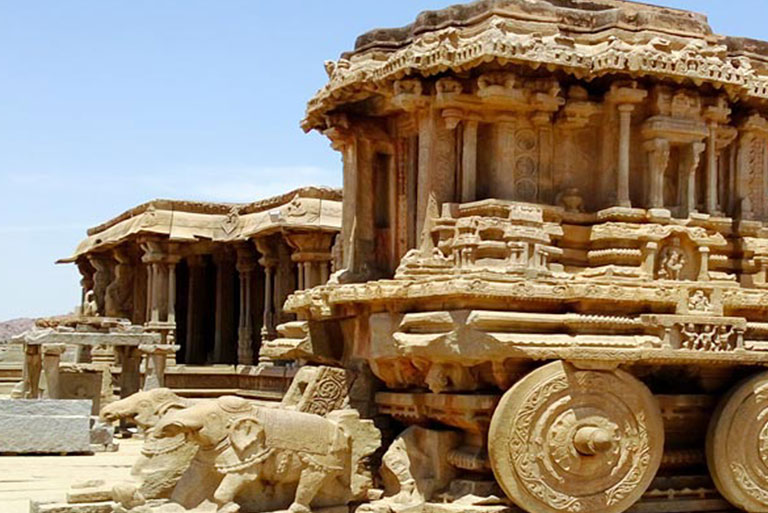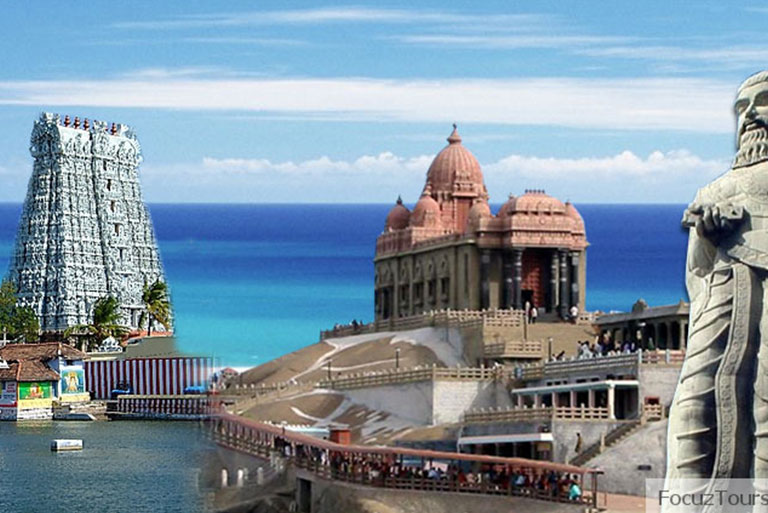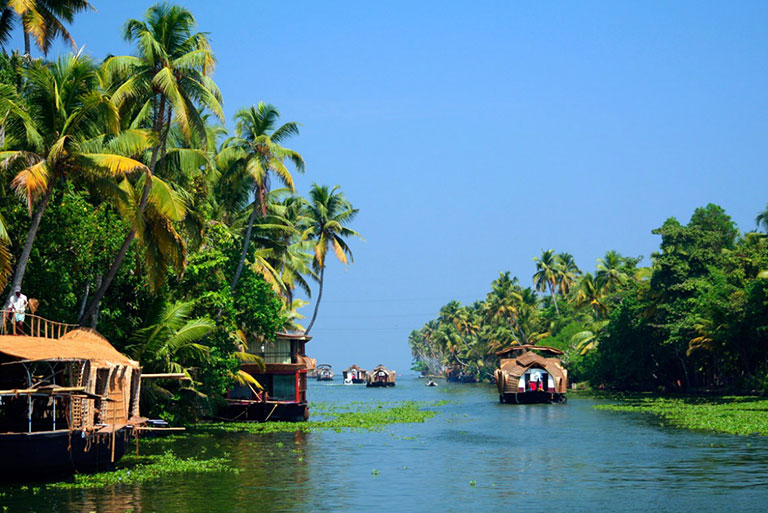South India Tour
Day.01 Sunday 12th of January 2020 Paris – Chennai :-
Morning flight to Chennai.
Arrival in the night.
Transfer from the airport to the hotel.
Overnight at the hotel in Chennai.
Day.02 Monday 13th of January 2020 Chennai :-
Today renamed Chennai, the small English counter of Madras founded in the seventeenth century
around a few villages, is the flagship city of a thriving South India.
The discovery of the city will begin with a panoramic tour by bus. It will allow us to
see, from the outside, the temple of Kapalishwara, dedicated to Shiva “master of the skulls”, which will be
a good introduction to the world of Dravidian temples.
Then, in the same district of Mylapore, visit the cathedral Saint-Thomas, built
according to the tradition on the burial of the apostle, will be the opportunity to discover the origins
very ancient Christianity in India.
Finally, the discovery of the remarkable collection of Chola bronzes in the Government
Museum will familiarize us with different currents of Indian spirituality.
Lunch during the visit.
Dinner and overnight at the hotel in Chennai.
Day.03 Tuesday 14th of January 2020 Chennai – Mahābalipuram :-
Departure for Mahābalipuram. Open porton the Bay of Bengal, the city was
centuries the port of the Pallava dynasty and
the starting point of the radiation of
Hindu culture to the eastern world.
The discovery of the city will begin with
the visit of the five rathas. These temples,
carved in granite blocks, and not
built, testify research
diversified that accompanied the genesis
Dravidian architecture in the seventh century.
Proudly standing on the shore where it seems to defy the marine elements, the temple of
the Greve, the first temple built and not excavated, favors the symbolic requirements
and rituals.
Pallava art also reaches heights in the relief of “The Ganges Descent”
by its unique composition by its size, its iconographic wealth and its artistic quality.
Thanks to this representation the dynasty could pretend to attract on the capital the blessing
of the god Shiva.
Finally, visit some of the less known caves, also decorated
remarkable reliefs, especially those of Durga and Krishna.
Lunch during the visit.
Dinner and overnight at the hotel in Mahäbalipuram.
(About 130 km)
Day.04 Wednesday, 15th of January 2020 Mahäbalipuram – Kanchipuram – Puducherry :-
Departure for Kanchipuram, holy city
Hindu to the many temples.
The so-called “Golden City”
is one of the seven holy cities of Hinduism.
She was one of the main art foci of South India
in the seventh and eighth centuries.
The Pallava dynasty, at the zenith of
his power, erected several temples
in the city.
Visit of Kailashanatha, dedicated to Shiva, masterpiece of Dravidian architecture.
It was built by the Pallava and did not suffer any alteration and destruction of the others
sanctuaries.
Then, discover the work of silk in one of the weaving workshops famous for
their silks throughout India.
Pursuit to Pondicherry.
Lunch during the visit.
Dinner and overnight at the hotel in Pondicherry.
(About 120 km)
Day.05 Thursday 16 January 2020 Pondicherry :-
Discovery of Pondicherry, whose familiar name, friend, recalls that India was also, for a time,
in French part. This was even the heart of French possessions in India, managed
by Dupleix, admirable politician, whose failure is due only to Parisian disavowal.
The English completely razed the lavish city of Dupleix and it was totally rebuilt
after the Congress of Vienna, especially under Napoleon III. Indian since only
sixty years old, the Old White City slumbers in his memories, rich colonial houses
drowned in tropical gardens, church of the Sacred Heart, cemetery of those who believed in this
daydream. It remains today the place where converge all those, which in India,
interested in Francophone culture, thanks to the dynamism of his French high school, the most
of Asia.
We will also visit the Sri Aurobindo Ashram and the Ganesh Temple, as well as
the flower market.
Lunch during the visit.
Dinner and overnight at the hotel in Pondicherry.
Day.06 Friday 17 January 2020 Pondicherry – Chidambaram :-
Gangaikondacholapuram – Tanjore
Departure for Chidambaram. Discovery in the center of the shrine city of Shiva Nataraja,
one of the great temples of Dravidian India. True religious city surrounded by several
enclosing walls, the temple of Knowledge is pierced by gopuram surmounted doors.
Inside there are many sanctuaries, dance halls or meeting halls for
the Brahmans who watch over the ritual, a huge pool, courtyards with crowds
devotees laden with garlands of flowers and fruit for the offerings. The holy of holies,
the roof covered with gold, houses the image of Shiva, represented as Nataraja “King of Dance”.
Departure towards Tanjore.
If Tanjore was the great capital of the Chola dynasty, which gave after the Pallava his age
gold to Dravidian art, many exceptional sites are in its territory. Among them,
the temple of Gangaikondacholapuram, now lonely in the Indian countryside,
offers a “feminine” version, all in grace, of the great temple of Tanjore.
Continue to Tanjore.
In Tanjore, capital and spiritual heart of the Chola, the most brilliant of the southern dynasties
from India, the temple of Brihadishvara famously celebrates its protector, Shiva. Served by
considerable resources, the architects of the year one thousand combined here the symbolic rigor
of space organization, monumentality, building the highest Vimana Tower of India,
crowned with a monolith of 80 tons, and artistic perfection, dazzling in the multitude
reliefs adorning the walls of the temple. Unparalleled religious work in South India,
daring continuity of the prestigious legacy of Pallava art, the temple was also wanted
as a monument raised to the glory of the Chola kings, thus celebrating their power
which extended, rare example in the history of India, beyond the seas.
In the Royal Palace, we will visit the museum, which exhibits a remarkable collection
Chola bronzes.
Lunch during the visit.
Dinner and overnight at the hotel in Tanjore.(About 170 km)
Day.07 Saturday 18 January 2020 Tanjore – Trichy – Madurai :-
Departure for Trichy.
Next to Trichy, dominated by its citadel located on a rocky outcrop, the temple Ranganatha Swamy is the most immense sanctuary of India.
On an island drawn by the Kaveri River, the temple-city, whose enclosure exterior delimits a perimeter sixty hectares, divided by seven successive ramparts, traces the history from the country.
This is where vishnuism was developed, especially at the instigation of the great philosopher Ramajuna. Since the dawn of time, each sovereign wanted to honor Vishnu in increasing its wealth by successive additions. If the heart of the sanctuary remains inaccessible to non-Hindus, immersed in the crowd of the faithful, we will discover the magic of the place by exploring the proliferation of speakers, gopuram gates, hypostyle courts and of adjoining temples that precede it. This group was built between the 13th and the 18th century, notably by the dynasty Nayak of Madurai.
Continue to Madurai.
Already quoted at the end of the fourth century BC by the Greek historian Megasthenes, Madurai welcomed around the Christian era, the Sangam, academies that gave Tamil literature gives it its nobility.
In the center of the city, his physical and spiritual heart, the temple of MinakshiSundareshwara is not dedicated to a god, but to a couple, that of Minakshi, goddess local assimilated to the goddess Parvati, and divine sound Shiva husband. In this double temple, labyrinthine, Abundant chapels annexes and sculptures, the crowd all day long presses to pray, invoke, and also to hang out and chat under divine protection.
Lunch during the visit.
Dinner will be taken early for an evening transfer rickshaw at MinakshiSundareshwara Temple.
We will attend the daily wedding ceremony Shiva (optional).
Overnight at the hotel in Madurai.(About 200 km)
Day.08 Sunday, January 19th, 2020 Madurai – Périyar :-
Early departure to Périyar. The Périyar reserve, founded in 1934, is located in the chain
mountains of Western Ghats. Our route to Périyar will allow us to appreciate
the wild beauty and luxuriance of the High Ranges.
Visit of a spice garden.
End of free day that will allow you to visit the reserve or to devote
massages.
At the end of the day, we will see a demonstration of Indian martial arts then
to an Ayurvedic medicine session.
Lunch during the visit.
Dinner and overnight at the hotel in Périyar.
(About 155 km)
Day.09 Monday 20th of January 2020 Périyar – Allepey – Backwaters :-
Departure to Allepey through the hills of tea trees, cocoa and rubber trees.
In the late morning, boarding and
typical lunch aboard a houseboat,
traditional boat, tastefully furnished,
for a cruise in the Backwaters,
maze of canals lined with vegetation
lush. Also used for
transport, trade in spices, rice,
of leather …, the Backwaters allowed
the development of the region.
Dinner and overnight aboard the houseboat.
(About 145 km)
Day.10 Tuesday 21 January 2020 Backwaters – Allepey – Cochin :-
Disembarkation in the morning in Allepey, a charming little town crisscrossed with lined canals
by lush vegetation, once a stopover of Arab and Chinese merchants.
Departure for Cochin. Portuguese counter in the 16th century, then Dutch city before
become English, Cochin lives for centuries in the fragrance of spices, pepper,
cinnamon, cardamom or nutmeg.
The Christian tradition has remained particularly strong in this region as we
see it at St. Francis Church, where Vasco da Gama was buried.
Cochin prides itself on its small Jewish community, probably here
the destruction of the temple in 70. The oldest synagogue in India, which we will see of
the exterior dates from the 16th century and is decorated with Chinese faience tiles. She hosts
the last families who preferred India to Israel.
Beside, the Dutch palace, actually built by the Portuguese for the royal family
of Cochin, home to the most beautiful collection of frescoes in Kerala, evoking the epic of Ramayana
and the life of the god Krishna.
We will also take a walk along the Arabian Sea to admire the work
sinners manipulating Chinese squares.
At the end of the day dance lessons and classical music in a cultural center.
In the evening, possibility to attend a Kattakali dance show.
Lunch during the visit, with Kerala cooking class.
Dinner and overnight at the hotel in Cochin.
(About 55 km)
Day.11 Wednesday 22nd of January 2020 Cochin – Bangalore – Srirangapatnam :-
Mysore
In the morning, transfer to the airport and flight to Bangalore.
Continue to Mysore. Along the way, discover Srirangapatnam, located on an island
of the Kaveri River. It was the capital of Haider Ali and his son Tipu Sultan at the end
eighteenth century. They were the last Indian monarchs to oppose fierce resistance
to English ambitions for over thirty years.
Lunch during the visit.
Dinner and overnight at the hotel in Mysore.
(About 150 km)
Day.12 Thursday 23 January 2020 Somnathpur – Mysore :-
The morning will be devoted to the discovery of the temple
of Somnathpur, remarkable for beauty and preciousness
of his sculptures, of infinite variety. This is one of the three
Hoysala style masterpieces.
Mysore is the first modern city designed in India
and the first electrified city in the world. It is punctuated
wide avenues and vast gardens. It is in this context
peaceful as goddess Durga, killing the demon
buffalo (symbol of all negativities), exterminated
the demons Cham and Mundi.
On the hill overlooking the city, the temple
of Chammundeshvari celebrates this major episode
of Hindu mythology. We will discover a statue
monumental of Nandi.
Far from the gravity of this cosmic drama, the palace
Maharaja, all in gilding, mirrors and mosaics, offers
surprisingly beautiful examples of the Liberty style.
Lunch during the visit.
Dinner and overnight at the hotel in Mysore.
Day.13 Friday, January 24, 2020 Mysore – Saravanbelgola – Hassan :-
Departure to Hassan. Along the way, discover a curious pilgrimage center
which reminds us that the Jain religion, although still a very small minority in India, was important
by the wealth of his followers. At the top of Saravanbelgola Hill, a statue
The colossal tenth century, which we will see from a distance, is among the largest in the world.
It commemorates the extreme asceticism of a saint jain who, absorbed by his meditation, left behind
creepers wrap around his legs.
Continue to Hassan.
This will be our starting point to explore the sites of Belur and Halebid, raised in the 12th
and thirteenth centuries by the Hoysala dynasty. Isolated on a high podium, the temples
present a curious starry plan, of a very rigorous geometry. Served by a material
tender, steatite, Hoysala sculptors chiseled lush reliefs, finesse
unequaled in Indian art, which reaches one of its peaks by refinement and lightness
shapes.
Lunch during the visit.
Dinner and overnight at the hotel in Hassan.
(About 180 km)
Day.14 Saturday, January 25, 2020 Hassan – Hospet :-
Day trip to Hospet.
Lunch along the way.
Dinner and overnight at the hotel in Hospet.
(About 300 km)



